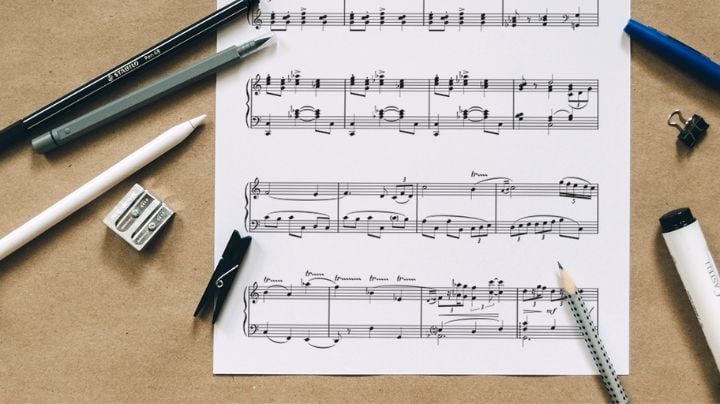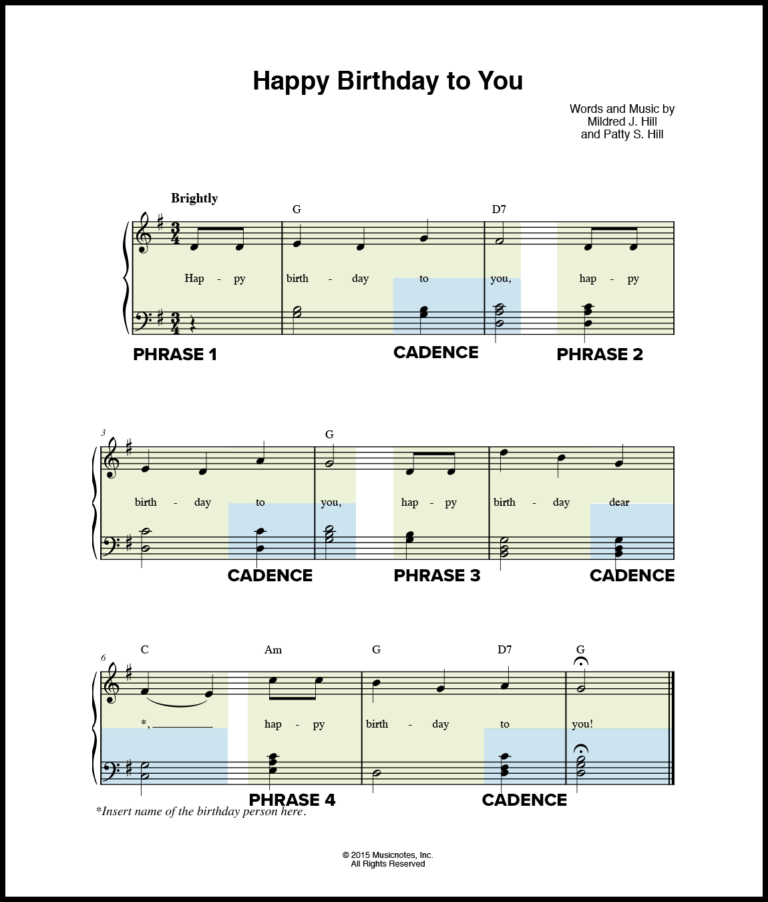An In-Depth Guide to Cadence in Music Theory: The 4 Types Explained
Read our guide on cadence in music and the four types you need to know like authentic, half, plagal, and deceptive! Grow your music theory knowledge today.

In music theory, a cadence is a two-chord progression at the end of a phrase in music. You can think of a phrase as a complete musical thought with the cadence being the end of that musical thought.
To illustrate, let’s look at an example of phrasing and cadences in “Happy Birthday to You.”

Listen to the melody while following along with the sheet music. Notice how each phrase has its own “complete musical thought.” As you come across each cadence, you’ll probably notice how some cadences sound complete and others leave you hanging. This because there are four different kinds of cadences:
- Authentic Cadence
- Half Cadence
- Plagal Cadence
- Deceptive Cadence
The Four Types of Cadence in Music
Authentic Cadences
An authentic cadence is a cadence from the dominant (V) to the tonic (I). Many times, a seventh is added to the V chord for an even stronger resolving sound. Authentic cadences are generally classified as perfect or imperfect.
- Perfect Authentic Cadences
In a perfect authentic cadence (PAC), the chords are in root position, meaning the roots of both chords are in the bass. In addition, the tonic will be in the highest voice of the final chord. This is generally considered the strongest type of cadence.

Examples of Authentic Cadence:
- "Happiness is a Warm Gun" - The Beatles
- "The Star Spangled Banner" - Francis Scott Key
Imperfect Authentic Cadence
There are three distinct types of imperfect authentic cadences (IAC):
- Root Position IAC: Similar to a perfect authentic cadence, but the highest voice is not the tonic.
- Inverted IAC: Similar to a perfect authentic cadence, but one or both chords are inverted.
- Leading Tone IAC: The V chord is replaced with the leading tone (viio) chord, but the cadence still ends on the tonic (I).

Though imperfect authentic cadences are very similar to authentic cadences, you’ll notice that they feel a bit weaker than authentic cadences.
Examples of Imperfect Authentic Cadence:
Half Cadence
A half cadence is any cadence ending on the dominant (V), regardless of which chord precedes it. Because it sounds incomplete or suspended, the half cadence is considered a weak cadence that calls for a continuation. Rarely do half cadences end a piece, but they are found many times in the first half of a chorus or verse. If you go back to our example of "Happy Birthday," let’s look at phrase 4, the final phrase of the piece. Taking the final G chord out of the equation, imagine if the piece ended on the D7 chord instead. Listen to the excerpt below and listen to how incomplete it sounds.

Examples of Half Cadence:
- "Baba O'Riley" - The Who
- "Learning to Fly" - Foo Fighters
Plagal Cadence
A plagal cadence is a cadence from the subdominant (IV) to the tonic (I). It is also known as the Amen Cadence because of its frequent setting to the text “Amen” in hymns. Here it is being used at the end of The Doxology Hymn.

The term “minor plagal cadence” is used to refer to the iv–I progression. Sometimes a combination of major and minor plagal cadence is even used (IV–iv–I). Though it’s rare, it’s quite the pleasing sound!

Examples of Plagal Cadence:
- "Dani California" - Red Hot Chili Peppers
- "No Surprises" - Radiohead
Deceptive Cadence
A deceptive cadence is a progression in which the dominant chord (V) resolves to a chord other than the tonic (I). In most cases, the dominant (V) will lead to the submediant chord (vi in major keys, VI in minor keys). The sound is “deceptive” because the listener expects a resolution to the tonic (I) and does not get it.

Examples of Deceptive Cadence:
- "And I Love Her" - The Beatles
- "Every Breath You Take" - The Police
Now that you’re a cadence expert, see if you can identify which types are in the next piece of sheet music you’re learning! To expand your music theory knowledge even further, check out our countless articles on our blog!

